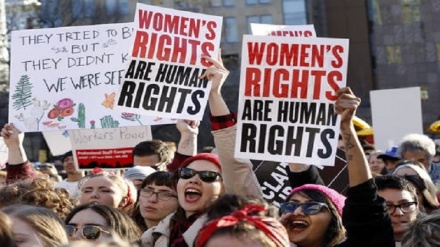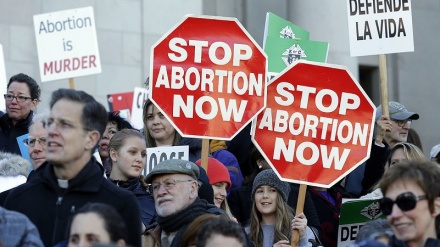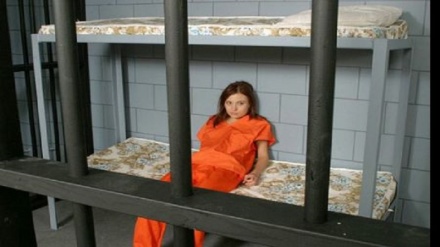Status of Women in the West (15)
Provision of the grounds to increase women's participation in vocations and decision-making is said to be among the goals of the third millennium development plan. According to many pundits, these goals have not materialized in either developing countries or even developed ones which masquerade to observe gender equality. One of these domains is cinema which, despite deafening claims in the west, is grappling with gender inequality.
In this part of the program let us listen to the remarks of Ms. Elham Akhundan, expert of the program,
"In spite of the mottos of gender equality and activities of feminist movements in western countries, several reports and evidence indicate discriminatory use of women in cinema industry. The research of Annenberg School of Communication and Journalism of Southern California University, which was conducted under the aegis of the UN, shows that less than one third of dialogues in movies are given to women. The report adds that just 22.5% of the jobs related to cinema industry are at women's disposal and this figure drops to less than 15% in jobs such as economic and political management, and scientific, technological and engineering domain. The report, which has been prepared via examining the movies from Australia, Brazil, China, France, Germany, India, Russia, South Korea, the United States and Britain, women are used twice more than men for sexual attractions. Therefore, the presence of women in cinema is mostly done for instrumental usage and their human dignity and value as woman and gender equality is never observed."
The first cinema star in the US was Florence Lawrence. After her, the 6-year-old girl, Shirley Temple from California, successfully turned to the most money-making and popular star of Hollywood. At that time, women like Hedda Hopper and Louella Parsons were gossip columnists and critics whose articles were read by millions and caused the success and defeat of a movie with their articles. Today, however, more than a century after the birth of Hollywood, women as the effective factors behind the growth and success of this filmmaking giant, have been marginalized and turned into subordinate characters.
Helen Mirren, British actress who campaigns gender inequality in film industry, said, "If you look at movies just now, you'll see that the number of women who have the main roles is very much less than men."
She describes the manner of choosing players in the western cinema as stupid. As the three-time winner of the Golden Globe, Mirren believes that this stupid method makes young women as partners of old men. This 69-year-old actress won Oscar Award of the first female role for acting as Queen Elizabeth II in the film The Queen in 2006. In an interview, she castigated the view of film industry of women and described as oppressive the habit of abandoning actresses due to their age. She said, "These issues will never change. We all see that James Bond is getting older every day but his partner is getting younger in every film. This is very disturbing."
Hollywood, as a profession, has treated women as second-class citizens. The wide salary gaps, the number of awarded prizes, and the number of female directors working in Hollywood manifest one of the most male-dominated cinematic centers in the world. For instance, during nearly 90 rounds of Oscar Awards, only one woman has succeeded in garnering the prize for the best director. She was Kathryn Bigelow who won the prize in 2009 for the film "The Hurt Locker".
The recent exposure of salaries, which is usually a secret of filmmaking studios, has caused a big scandal. When Hilary Swank, as a twice winner of Oscar Award, announced that her partner was paid ten times more than her, she indeed disclosed a picture of Hollywood which resembles more to the medieval years rather than the 20th century.
The publication of some statistics unmasked the grave situation of women in Hollywood. These statistics showed that out of 1300 box-office hits during 2002-2014, a mere 4% were made by female directors. These figures revealed the mistrust of big studios and Hollywood tycoons in female filmmakers. However, the farther we go from Hollywood and long story cinema, the more logical and fair these figures become. For example, women in the independent cinema, in which the absolute rule of capital is harnessed to some extent, women have demonstrated more power and activity and in 2002-2012, approximately 24% of directors participating the Independent Film Festival were women. During this period, 58% of the women who had tried to make a film but had failed, mentioned economic problems as the main cause for their failure. This proves that producers, who are generally men, were not ready to employ women in their costly projects. With such a mindset, if in 1998, 9% of the films were made by women, in 2011 the figure dropped to 5%; while in the same period, only four films made by male directors inflicted a loss of more than 5 million dollars.
With respect to the disappointing currents in recent years, it can be concluded that Hollywood is not a good host at all for women. Statistics reveal that in the years 2013 and 2014 only 6% of Hollywood films were directed by women. More interesting is that, with this small number of female directors, the number of women watching films usually surpasses men. To put it more simple, it is usually the men who make movies for women. Apart from gender discrimination, this imbalance has caused many cultural consequences.
Claire Johnston, feminist film theoretician, maintained that the role of women is subordinate and their presence is an auxiliary for the male hero. She said that in Hollywood, man is the active and woman is the passive character. Even the pleasures in the films are designed in way to exclusively satisfy men. Especially that, in these films, women are considered with a sexual look to the extent that most of the films in the west will not meet the viewer's expectation if they lack sexual look at women. A research by Annenberg School of Communication and Journalism of Southern California University on 100 Hollywood films proved that the emphasis on women's sexual attraction has increased manifold. This look has been internalized so much so that nobody feels concerned or annoyed that such pictures are shown of women. This is a manifest evidence of the decadent and corrupt culture in the west.
RM/SS


